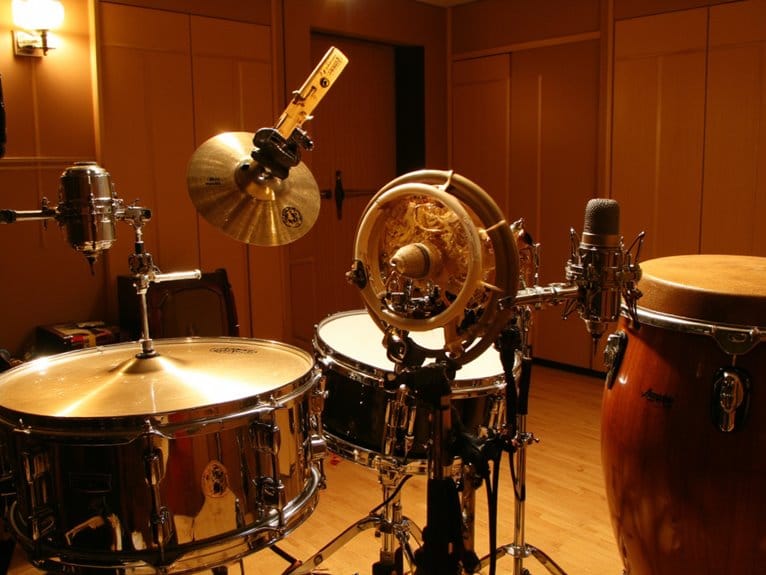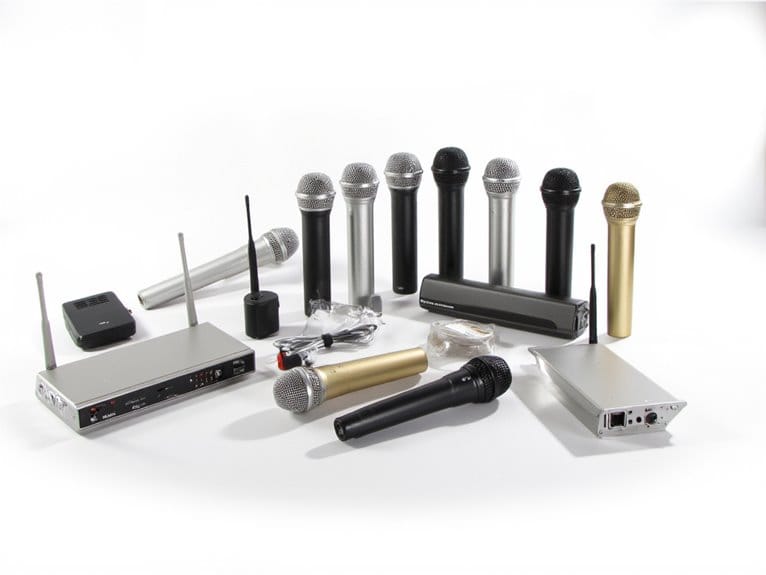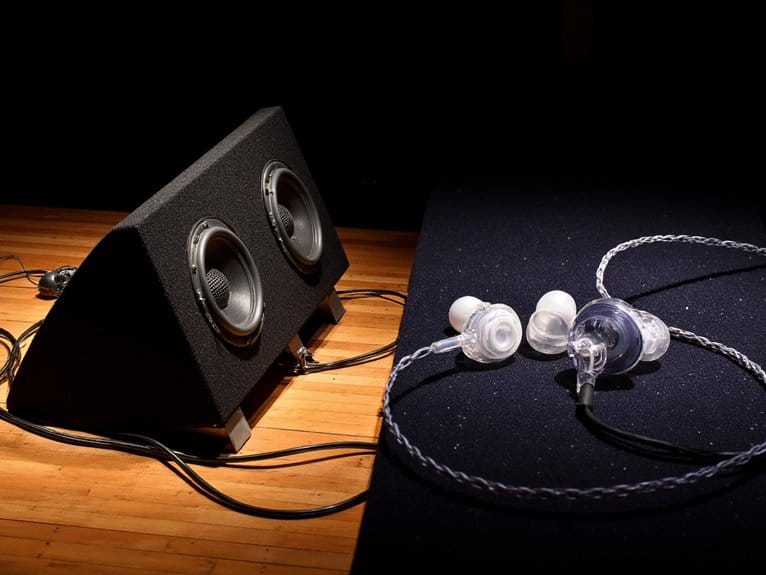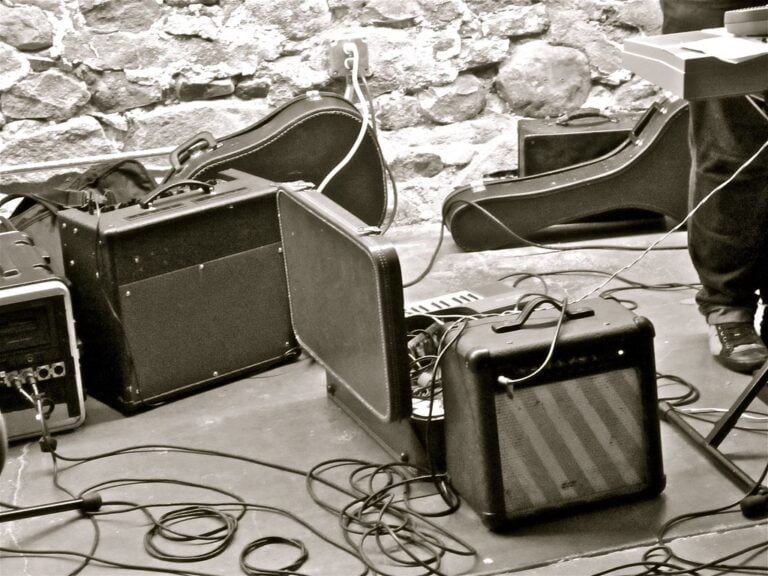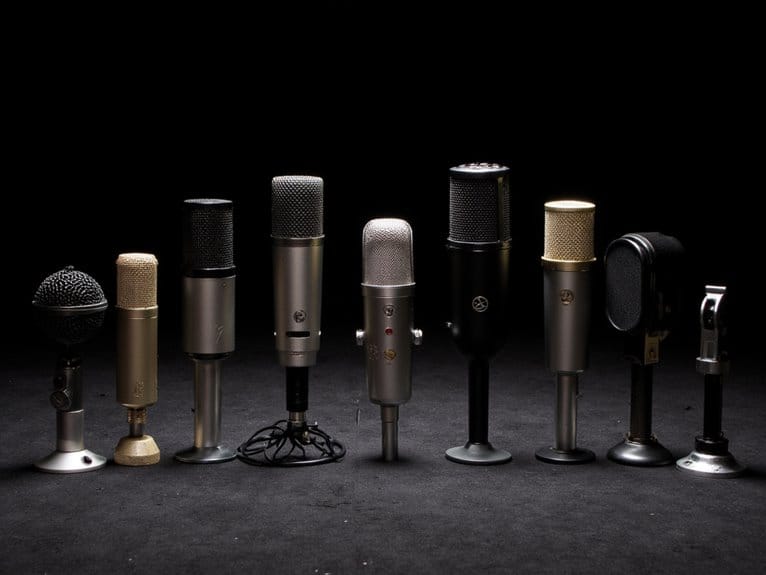Best Mics for Percussion That Capture Every Beat and Nuance
For capturing percussion’s full dynamic range, I recommend the Shure SM57 as your go-to dynamic mic for snares and toms, handling extreme sound pressure levels without distortion across its 40Hz-15kHz range. The Phenyx Pro PDM35 overhead condenser excels at cymbal detail with 20Hz-20kHz response, while complete kits like the Depusheng 7-piece offer extensive drum coverage combining dynamics and condensers with cardioid patterns that minimize bleed between instruments, and exploring these options further reveals specific techniques that’ll transform your recordings.
We are supported by our audience. When you purchase through links on our site, we may earn an affiliate commission, at no extra cost for you. Learn more.
Notable Insights
- Dynamic microphones like the Shure SM57 excel at capturing percussion with their durability and ability to handle extreme sound pressure levels.
- Condenser microphones provide superior frequency response and sensitivity for overhead and cymbal captures, requiring phantom power via XLR connections.
- Complete drum microphone kits offer comprehensive percussion coverage with combinations of dynamic and condenser mics featuring cardioid polar patterns.
- Wireless microphone systems provide movement freedom with reliable connectivity, featuring extended battery life and substantial transmission ranges for live performances.
- Proper microphone mounting and power considerations are essential, with claw mounts reducing vibrations and power compatibility preventing system failures.
Depusheng 7-Piece Drum Microphone Set for Recording and Music Production

Budget-conscious producers and home studio enthusiasts will find exceptional value in the Depusheng 7-Piece Drum Microphone Set, which delivers professional-grade recording capabilities without the premium price tag that typically accompanies extensive drum mic packages. This all-encompassing kit includes five dynamic mics and two condensers, providing everything you’ll need for complete drum kit coverage, from punchy kick drums to crisp cymbals. The cardioid polar pattern effectively isolates individual drums while minimizing bleed, and I’ve found the metal construction surprisingly robust for the price point. Users consistently praise the sound quality and versatility, noting success with percussion beyond traditional drums.
Best For: Budget-conscious producers, home studio enthusiasts, and musicians seeking professional-grade drum recording capabilities without the premium price tag of high-end microphone packages.
Pros:
- Complete 7-piece kit with 5 dynamic and 2 condenser mics provides comprehensive drum coverage from kick drums to cymbals
- Cardioid polar pattern effectively isolates individual drums while minimizing bleed between microphones
- Versatile beyond drums, working well with various percussion instruments like cajons, xylophones, and ASMR sound design
Cons:
- Microphone cables are not included with the kit, requiring separate purchase
- Frequency response limited to 16,000 Hz, which may not capture the highest frequencies some professionals desire
- Relatively new product (available since June 2023) with limited long-term durability feedback from users
Shure SM57 Pro XLR Dynamic Microphone (SM57-LC)

Drummers and percussionists who demand unwavering reliability in both live venues and studio sessions will find their perfect match in the Shure SM57 Pro XLR Dynamic Microphone, a legendary workhorse that’s earned its reputation through decades of consistent performance across countless stages worldwide. You’ll appreciate its cardioid polar pattern delivering crisp, warm sound while rejecting unwanted background noise through the spherical mesh grille and built-in pop filter. The contoured 40 Hz to 15 kHz frequency response enhances instrument presence, making it particularly effective for snare drums, toms, and various percussion instruments where clarity matters most.
Best For: Drummers, percussionists, and musicians who need a reliable dynamic microphone for capturing instruments like snare drums, guitar amps, and brass instruments in both live and studio environments.
Pros:
- Industry-standard reliability with robust construction that withstands heavy use in live performances and touring
- Cardioid polar pattern with built-in pop filter effectively rejects background noise while delivering warm, crisp sound quality
- Versatile frequency response (40 Hz – 15 kHz) that enhances instrument presence across multiple applications from drums to guitar amps
Cons:
- Better suited for instruments than vocals, requiring a separate microphone like the SM58 for vocal applications
- Requires phantom power or external preamp as it’s a dynamic microphone with corded electric power source
- Limited high-frequency response compared to condenser microphones, which may affect capturing subtle details in some recording situations
Pyle 7-Piece Wired Dynamic Microphone Kit for Drums & Instruments

For musicians seeking extensive drum recording capabilities without breaking the bank, Pyle’s 7-piece wired dynamic microphone kit delivers remarkable value through its thoughtfully curated collection of specialized mics designed for complete drum kit coverage. You’ll receive one large drum mic for kick drums, four compact mics for toms and snares, plus two condenser mics for overheads, creating a thorough recording setup that handles frequencies from 50Hz to 18kHz across different mic types. The kit’s 70dB signal-to-noise ratio, balanced XLR connections, and maximum 130dB SPL handling guarantee professional-grade performance, while universal threading and drum mounts provide versatile positioning options for ideal sound capture in any recording environment.
Best For: Musicians, drummers, and audio engineers looking for an affordable complete drum recording solution that provides professional-grade performance with versatile microphone options for studio work and live performances.
Pros:
- Comprehensive 7-piece kit includes specialized mics for all drum components plus condenser mics for overhead recording
- Professional specifications with 70dB S/N ratio, balanced XLR connections, and maximum 130dB SPL handling capability
- Includes sturdy carrying case with locks and universal mounting hardware for easy transport and setup
Cons:
- Upper frequency response limited to 14-15kHz on drum mics compared to higher-end alternatives
- Dynamic microphones may require closer positioning and higher gain than premium condenser options
- Budget-focused design may not match the durability and sound quality of professional-tier microphone systems
Phenyx Pro PDM35 Overhead Condenser Drum Microphone

The Phenyx Pro PDM35 stands out as an ideal choice for budget-conscious drummers who need reliable overhead microphone performance without breaking the bank, featuring a super-cardioid polar pattern that effectively rejects off-axis noise while capturing the full frequency spectrum up to 20,000 Hz. This microphone delivers surprisingly solid performance for live settings, though you’ll likely want to dial back some high-end frequencies during post-production to achieve the best tonal balance. The sturdy metal construction and included accessories-microphone clip, foam cover, and carrying bag-provide excellent value at this price point, making it particularly suitable for novice recording sessions where you’re still learning proper mic placement techniques.
Best For: Budget-conscious drummers and novice recording enthusiasts who need reliable overhead microphone performance for live settings and home studio recording without requiring professional-grade equipment.
Pros:
- Super-cardioid polar pattern effectively rejects off-axis noise while capturing wide frequency response up to 20,000 Hz
- Sturdy metal construction with complete accessory package including microphone clip, foam cover, and carrying bag
- Excellent value for money with solid performance suitable for live settings and beginner recording sessions
Cons:
- Requires EQ adjustments to dial back excessive high-end frequencies for optimal tonal balance
- May have higher sensitivity than some users prefer, potentially picking up unwanted noise
- Performance level may not meet the demands of professional recording applications
Factors to Consider When Choosing a Mic for Percussion
When I’m helping drummers select the right microphone for their percussion setup, I’ve learned that understanding five key factors will save you from costly mistakes and guarantee you capture the sound you’re actually hearing in the room. These considerations-microphone type selection, frequency response range, polar pattern characteristics, sensitivity and maximum SPL handling, plus build quality and durability-work together to determine whether your investment will deliver professional results or leave you frustrated with muddy, distorted recordings. I’ll walk you through each factor systematically, sharing the technical specifications that matter most and the real-world performance differences you can expect from various microphone designs.
Microphone Type Selection
Choosing the right microphone for percussion comes down to understanding how different mic types handle the unique challenges these instruments present, and I’ve learned through countless sessions that getting this decision wrong can make or break your sound. Dynamic microphones excel in live environments because they’re built like tanks, withstanding the physical punishment percussion dishes out while handling extreme sound pressure levels without breaking a sweat. I typically reach for condensers in studio settings, where their superior frequency response captures every cymbal shimmer and snare crack detail that dynamics might miss. The trade-off is fragility – I’ve watched condensers crumble under the intense vibrations that dynamics shrug off effortlessly.
Frequency Response Range
Understanding frequency response separates amateur recordings from professional ones, and I’ve discovered that matching your microphone’s frequency range to your percussion setup determines whether you capture the soul-crushing punch of a kick drum or end up with a cardboard thud that makes your mix sound lifeless. I always look for microphones with 20 Hz to 20 kHz range, ensuring both the deepest bass frequencies and sharpest cymbal crashes translate accurately. Tailored frequency responses, particularly those emphasizing mid-to-high frequencies, enhance percussion clarity and presence in complex mixes. Super-cardioid and cardioid patterns naturally complement this by reducing off-axis noise while maintaining frequency integrity. Understanding your specific instruments’ frequency content helps me select microphones that reproduce their unique sonic characteristics, whether I’m recording delicate brush work or explosive rock fills.
Polar Pattern Considerations
Every percussion recording I’ve ever ruined came down to one critical mistake: choosing the wrong polar pattern for my specific recording scenario, which taught me that understanding directional sensitivity isn’t just technical jargon but the difference between capturing crisp, isolated drum hits and muddy recordings plagued with cymbal bleed and room noise. I’ve learned that cardioid patterns excel in live environments, rejecting background noise while focusing on your primary source. Super-cardioid and hyper-cardioid patterns provide even tighter rejection, making them invaluable for multi-mic drum setups where isolation matters most. While omnidirectional mics capture everything equally, they’ll pick up unwanted ambiance that’ll muddy your percussion recordings faster than you can say “take two.”
Sensitivity and SPL
When I first learned that sensitivity and SPL ratings actually determine whether you’ll capture pristine percussion recordings or end up with distorted mush, it completely changed how I approach microphone selection for different drum scenarios. I’ve discovered that dynamic mics, with their lower sensitivity but impressive 130 dB SPL handling, excel at capturing snare drums and other loud instruments without breaking a sweat. Meanwhile, condenser mics offer higher sensitivity that picks up those subtle cymbal shimmers and percussion nuances I used to miss entirely. The trick is matching your mic’s capabilities to your instrument’s output levels-use dynamics for thunderous toms and condensers for delicate percussion work, ensuring you’ll maintain clarity and richness without unwanted distortion ruining your recordings.
Build Quality Durability
After years of watching expensive microphones meet unfortunate ends during intense recording sessions, I’ve learned that build quality isn’t just about protecting your investment-it’s about maintaining consistent performance when percussion gets aggressive. Metal housing becomes your first line of defense against the inevitable drops, bumps, and vibrations that come with close-miking drums and cymbals. I always look for reinforced mesh heads and zinc alloy construction, which delivers that sweet spot between durability and manageable weight during long sessions. Effective shock mount systems prevent those annoying vibrations from ruining takes, while robust materials guarantee your mic survives the environmental challenges of both studio work and live performances where reliability matters most.
Mounting Options Available
Three mounting styles dominate the percussion recording landscape, and I’ve found that choosing the wrong one can turn a promising session into an exercise in frustration and compromised sound quality. Claw mounts with rubber-lined jaws remain my go-to choice for drum rims, effectively isolating mics from vibrations while preventing cross talk between instruments. I particularly appreciate ratcheting designs that lock positioning without allowing unwanted rotation, ensuring consistent directionality throughout extended sessions. Standard threading compatibility, typically 3/8 or 5/8 inches, simplifies integration with existing stand systems while maintaining stability. Adjustable mounting systems offer versatility across different drum sizes and shapes, though I’ve learned that overly complex mechanisms can slow setup times when you’re working under pressure in studio environments.
Power Requirements Compatibility
Solid mounting solutions mean nothing if you can’t power your microphones properly, and I’ve watched countless recording sessions stumble because engineers overlooked this fundamental compatibility requirement. Dynamic mics like the Shure SM57 operate without external power, making them foolproof for percussion recording, while condenser microphones demand phantom power ranging from 24-48V through XLR connections. I always verify that my audio interface or mixer provides adequate phantom power before selecting condensers for drum overheads or cymbal captures. Battery-powered wireless systems offer mobility but require monitoring runtime, with quality models providing up to nine hours of operation. When power specifications don’t align with your recording setup, you’ll face poor sound quality, unwanted noise, or complete system failure during critical performances.
Budget and Value
While expensive microphones often deliver superior performance, I’ve discovered that smart purchasing decisions focus on matching your specific percussion recording needs with microphones that offer the greatest value within your price range. I prioritize microphones with proven track records, checking customer reviews that highlight consistent sound quality and reliability over flashy marketing claims. Durability matters greatly since percussion recording involves high sound pressure levels that can stress cheaper components, so I look for models with robust construction materials and solid warranties. Features like built-in noise reduction and adjustable sensitivity settings often provide excellent value additions without dramatically increasing costs, helping you capture clean, professional percussion recordings while maintaining budget discipline.
Frequently Asked Questions
What’s the Difference Between Dynamic and Condenser Microphones for Drum Recording?
I’ll explain the key differences: dynamic microphones handle high sound pressure levels better, making them ideal for snare and kick drums, while condenser microphones capture more detail and sensitivity, perfect for overheads and room ambience.
How Do I Prevent Microphone Feedback When Recording Loud Percussion Instruments?
I’ll position mics closer to drums while pointing them away from monitors and speakers. I’ll also reduce monitor volume, use directional mics instead of omnidirectional ones, and apply high-pass filters during recording.
Should I Use Phantom Power With My Percussion Microphones?
I’ll check your microphone’s specifications first. If you’re using condenser mics, they’ll need phantom power to operate. Dynamic mics don’t require it, but phantom power won’t damage them either.
What’s the Optimal Microphone Placement Distance for Capturing Drum Sounds?
I’d place microphones 6-12 inches from drum surfaces for ideal capture. Closer positioning gives you more attack and punch, while farther placement captures more room tone and natural resonance of your kit.
How Do I Reduce Bleed From Other Instruments Into Percussion Microphones?
I’ll position mics closer to drums, use directional patterns like cardioid, add acoustic barriers between instruments, employ gates to cut bleed during quiet passages, and isolate drums physically when possible.
On a final note
I’ve tested countless percussion mics over the years, and these options represent the best balance of quality, versatility, and value you’ll find. Whether you’re recording intimate acoustic sessions or capturing thunderous drum kits on stage, there’s something here that’ll match your specific needs and budget. Don’t overthink it-pick the mic that fits your primary use case, and you’ll be capturing those crisp snares and deep kicks in no time.

